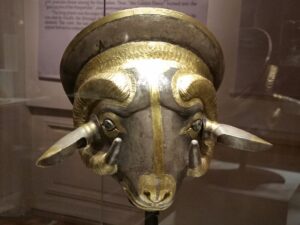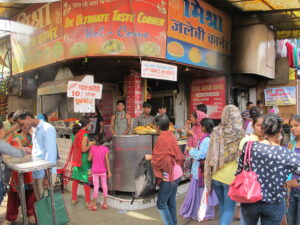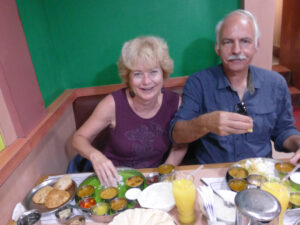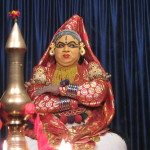
His yellowed face was still. The heavily kohl-outlined eyes went left, then right. Left, then right, In rhythm to the drum beat now, left, right, left, right. Now up, down, up down, up down, in rhythm. Over and around, over and around, faster now, over and around. Then the heavily painted chevrons of the eyebrows arched up and down, up and down, again to the thrumming of the drum.
Then he demonstrated the nine emotions or navarasams – love, disgust, anger, peace and so on – each formed from a time-honored template of facial movement emphasized by the heavy makeup, hand gestures and body position.
The actor was illustrating the traditional gestures and movement used by actors in Kathakali, classic Keralan dance drama. Really more mime than dance, this theatrical style dates from the 16th century, but with sources much further back in time. To round out his painted face, this pudgy male actor was elaborately dressed in drag with extensive jewellery and necklaces, as well as traditional billowing costume, all befitting his role later as the daughter of a king.
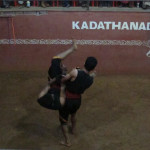
Though relatively inactive, this performance was already far more interesting than the flashy display of traditional Keralan martial arts in the hour beforehand. That show alternated some gymnastic exercises with circus-style set pieces, like jumping thru a fiery hoop or severe body twisting or baton-twirling like a cheerleader from Game of Thrones. Alternating with such gymnastics were somewhat more interesting staged fights, featuring great leaps in the air and threatening crouches. The fights showed how to confront an enemy no matter what weapons you have, including none at all: We never knew how useful a weapon a ropey ribbon could be, even against a sword. And you can hog-tie your opponent at the end.
But the martial and dramatic arts are entwined with each other. Apparently, for as much as 8 to 10 years, the Kathakali actors undergo the same kind of intensive training as their warrior counterparts.
But back at the relative stillness of the dance drama, we continued to be enthralled by the smallest gestures. After showing us the emotional range of his art, the actor mimed a scene between a mother and baby. She first adorned herself, then comforted the crying child, occasionally switching to that role as well. She then breast-fed the baby, dealt with a wet hand and finally put the child to sleep – and showed one of those nine emotions, peace.
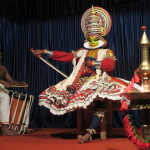
Typically a Kathakali performance retells ritualistic stories of gods and warriors from the Mahabharata and other Indian epics, or morality tales from other ancient sources. Characters are often types rather than specific individuals, somewhat like European commedia dell’arte figures, telling age-old moral tales. The dramas would occupy the better part of an evening in their original forms, but are often shortened in practice as was the scene we saw, about 20 minutes long. And, though mostly mime, Kathakali does have moments where the actors dance in the simple style (kalasam, or decorative movement) allowed by the cumbersome costumes. All plays have musical accompaniment, a simple band of bells, chimes and drums accompanied with a singspiel, a narrative chanted by one of the musicians.
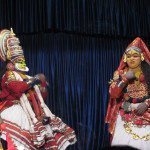
The scene we saw after the demonstration was previewed by an announcer, but he talked too closely into the microphone to be understood thru the distortion. The best we could make out, the daughter of a king wanted to marry someone but he did not approve. The argument between them gets more and more heated, with his asserting his authority and she wheeling and dealing in response. Toward the finish, he seems to put a curse on her and she grows a beard, then flees screaming stage left. Or something like that.
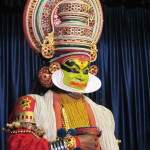
The actor playing the king was more showy in gestures as well as costume. His face was colored in the traditional pachcha (green) role, one of nobility, but with a bit of evil in it. Around him, he wore a huge hoop skirt and golden headdress. In the scene’s climax, he did a triumphant dance, side to side, forward, back, side to side. His skirt whirled round, with the bells arrayed on it tinkling over the more intense banging of the drum.
And then came the photo ops. Audience members trickled up to pose alongside the actors and stand still for a photo. The announcer called for tips and the audience filed out.
In other respects, the small crowd of Indians had been peculiar and somewhat disrespectful. Very young kids who had no reason to be there wailed in their seats. Adults got on their phones or chatted loudly with each other. Two men in the front row arose and roamed around during the demonstration.
What were they thinking? Is this just typical tourist behavior: we’re on holiday and therefore indifferent to the normal rules of attention and respect to the performers? Or is this behavior more typical of Indian audiences, akin to the irreverent crowds at Western performances before a church-like atmosphere became the norm in the late 19th century? Some Indians in the audience seemed bothered by all the misbehavior, but we had not experienced formal theatrical performances in India so are somewhat in the dark.
The actors and musicians, of course, just kept performing in spite of all this. Perhaps this evening, though, they jingled a little louder and drummed a lot stronger in response.
(Also, for more pictures from India, CLICK HERE to view the slideshow at the end of the India itinerary page.)



